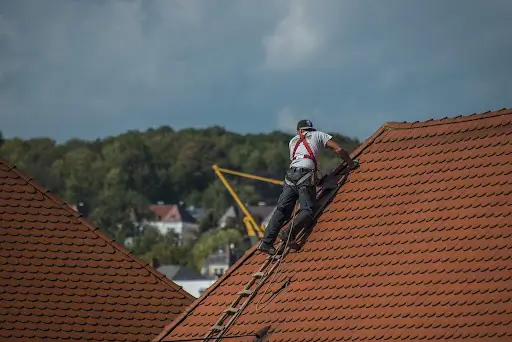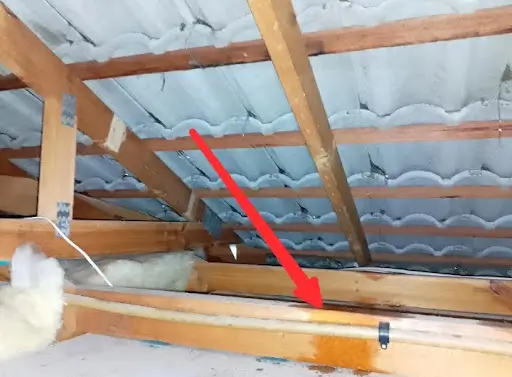Have you woken up after a storm to find another loose tile and water dripping through the ceiling? Or sick of hearing your roof crack and pop over a 38°C roof space every hot afternoon?
We receive numerous calls from Adelaide homeowners who are struggling with noisy roofs, fading tiles, and ongoing repairs that seem never-ending.
It’s usually when the big question hits: is it time to switch to Colorbond®, or should I just stick with tiles?
Colorbond® roof vs. tile: which is the best? Well, here’s a quick answer:
If you live anywhere in Adelaide where you experience a lot of heat, coastal air, and unpredictable weather, Colorbond® is a no-brainer. They don’t creak with temperature swings, leak after heavy rain, or demand constant repointing.
For families living in older tiled homes or anyone tired of patch jobs and ceiling stains, this choice isn’t about looks. It’s about peace of mind and long-term value.
After four generations of roofing services in Adelaide covering thousands of roofs across Adelaide, we’ve seen the good, bad, and downright frustrating sides of both roofing materials. Here’s what experience and local data tell us.
Let’s get one thing straight. Both roofs do the job, but they’re built differently.

A Colorbond® roof is made from pre-painted, high-tensile steel designed for strength, durability, and long-term weather resistance. The core is coated with zinc-aluminium alloy (Zincalume) for corrosion resistance, followed by a baked-on primer and a durable, pre-painted outer finish. This layered construction creates a weather-resistant and long-lasting roofing material available in a wide range of colours. Southerly, Basalt®, Woodland Grey®, and Surfmist® are crowd favourites in Adelaide.

Source: https://www.roofandrender.com.au/is-a-metal-roof-more-energy-efficient-than-tile
Tile roofing, on the other hand, can be made from concrete or terracotta. They’re heavy, solid, and have that classic “Aussie home” look you see on Federation-style houses. But that weight (roughly 47 to 52 kilograms per square metre) means extra stress on your roof framing.
From our experience removing old tiles to installing new metal roofing systems, what we’ve learnt is this: material choice should match your home’s style, age, and the local conditions it faces daily.
Here’s a snapshot comparison:
| Feature | Colorbond® Roof | Concrete/Terracotta Tiles |
| Weight | 5–9 kg/m² | 47–52 kg/m² |
| Lifespan | At least 45 years | 20–30 years |
| Maintenance | Low | Moderate–High |
| Heat Reflectivity | Excellent (cool roof colours) | Retains heat longer |
| Cost (Adelaide avg.) | $50–$100/m² | $80–$120/m² |
| Warranty | Up to 45 yrs (BlueScope®) | Varies; often none |
| Common Issues | Minor denting | Cracks, leaks, moss growth |
Here’s a detailed analysis that can help you decide between tile and metal roofs like Colorbond®.
First, we’ll discuss what truly matters, which is staying watertight and shielded in the worst weather conditions.
Colorbond® steel is made for Aussie conditions. A modern Colorbond® roofing can last for 45 years or more. It’s also guaranteed by a 45-year BlueScope® warranty when installed professionally and maintained properly.
In addition, it’s backed by up to 36 years of corrosion warranty and 20 years of paint warranty from BlueScope®, depending on how close you are to the coast. In coastal spots like Aldinga Beach or Port Noarlunga, salt can be damaging, but marine-grade Colorbond® holds up well with minimal maintenance.
Because it’s lightweight, it doesn’t crack or shift like tiles under strong winds. And while severe hail can damage it, those dents rarely compromise its waterproofing.
Most concrete tiles typically last 20–30 years before showing major wear like cracking, colour fading, and ridge mortar breakdown.
Concrete and terracotta tiles don’t rust, but they’re fragile. We’ve seen plenty of old tiled roofs around Marion where a few broken tiles after a storm led to leaks that quietly ruined ceiling plaster over time. Once moisture gets in, repairs can snowball.
One Aussie homeowner also summed it up perfectly after dealing with a leaking Monier roof as seen in the picture below:

According to the homeowner, the tiles “leaked like a sieve, had zero warranty or accountability, and lost colour in under ten years.” In their words, going for tiles instead of metal roofing like Colorbond® was “asking for trouble.”
That concern isn’t rare. We’ve replaced plenty of roofs with Colorbond® because they simply hold up better against the Australian weather conditions. When you factor in heat, wind, and maintenance, Colorbond® keeps its edge year after year.
If you want it done right the first time, professional Colorbond roofing installation makes all the difference.
In Adelaide, replacing tile with Colorbond® roofing (including materials and labour) typically costs between $50 and $100 per square metre, depending on the roof pitch, design complexity, and optional extras like insulation or roof blankets.
On the other hand, according to Roof & Render SA, concrete tile roofing usually costs between $80 and $120 per SQM. That often appears cheaper upfront but costs more in the long run once you add maintenance, cracked tile replacements, and repointing over time.
Concrete tiles need repointing every 10 to 15 years. A properly fitted Colorbond® roof, on the other hand, might only need a clean and fastener check every few years.
Tiles might seem like a bargain at first, but once you include repointing, replacement tiles, and cleaning, Colorbond® often comes out ahead.
You can get a sense of how pricing stacks up in our roof replacement cost guide, which breaks down Adelaide averages clearly.
If you’re a busy homeowner who doesn’t fancy climbing on a ladder every year, check this out.
With tile roofing, ridge capping and repointing need redoing roughly every decade. Moss and lichen are constant battles, especially in leafy suburbs like Blackwood. Miss one inspection, and water might creep in before you even notice.
Colorbond® roofing is a different story. A simple clean once or twice a year and an occasional screw check over the years will keep it pristine. The paint finish resists cracking and fading even under harsh UV.
However, if your home still has old asbestos or fibre cement roofing, make sure to handle upgrades safely. Our asbestos roof replacement guide explains what’s involved before swapping to a safer Colorbond® alternative.
Let’s be honest, curb appeal matters too.
Colorbond® roofs fit modern designs perfectly. Think clean lines, minimalist façades, and colours that match your garden or garage door. It’s also ideal for low-pitch designs and homes with solar panels, thanks to its wide, smooth surface.
Tile roofing suits older homes better. A sandstone villa in Norwood or a Tudor-style home in Burnside looks authentic with tiles. But tiles add a lot of weight, up to ten times more than steel roofing. So, if you’re upgrading an older home, it might need additional structural support.
That’s often why people replacing old roofs choose a Colorbond® roof over tiles. It’s lighter, faster to install, and refreshes the look instantly.
Adelaide summers can roast a roof, and that heat radiates into the ceiling cavity. A reflective roof surface can literally change how your home feels.
Colorbond® roofs use Thermatech® technology, which can reduce roof surface temperature by up to 5–6°C in peak summer. That can make a noticeable difference to indoor temperatures and lower air conditioning costs.
Combine it with a roof blanket insulation and good ventilation, and your home’s thermal efficiency improves dramatically. Tiles, made from natural materials, have strong mass insulation but tend to retain heat, meaning your home stays warmer into the evening.
If energy savings and comfort matter most, you’ll get more consistent performance from a new Colorbond® roof with lighter shades like Surfmist® or Southerly.
Overall, it’s Colorbond if you ask us. But, again, you’ve got to look at your location and what you prioritise: durability, curb appeal, maintenance needs, cost and more.
After two decades on roofs across Adelaide, we’ve heard every opinion there is. But if you scroll through local home forums, the verdict’s starting to sound familiar.
One homeowner wrote that he “loves his tiles,” but admitted if you’re reroofing and don’t go Colorbond®, “you’re crazy.” He wasn’t wrong. Another user asked why, and a builder chimed in saying every new build he works on now has
Colorbond® roofing with proper insulation top and bottom in the ceiling cavity, “bulletproof,” as he put it. No leaks, no noise, and the best insulation he’s seen.
That matches exactly what we see on the ground. Every major new development across Adelaide (from Angle Vale to Aldinga) is going metal. Not for looks alone, but because it performs better.
Still not sure? Here’s a quick analysis of the advantages of each material and what to watch out for. They come from years of local installs:
• Lightweight and ideal for older roof frames
• Handles high winds and wild Adelaide storms
• Looks modern with low-pitch roof designs
• Reflects heat, improves comfort
• Low maintenance and long lifespan
Watch for: dents in heavy hail, and make sure your insulation is properly fitted.
• Great for traditional tiles look on older homes
• Naturally quiet in rain
• Easy single-tile replacement
• Good insulation mass
Watch for: cracks, fading, moss, and repointing costs.
So if you’re reroofing, Colorbond vs roof tiles isn’t really a 50-50 debate anymore. For most Adelaide homes, metal wins on durability, comfort, and looks.
Choosing between tiles vs Colorbond roof comes down to lifestyle. Do you want a roof that needs little care and keeps your home cooler? Or are you keeping a heritage look and don’t mind regular maintenance?
If you’re unsure, our crew can help you compare both options properly. We’ll check your current structure, insulation, and design, and quote each option side by side so you can make a confident decision.
Roof & Render SA isn’t a new name on the block. We’re a four-generation South Australian roofing company with over 100 years of experience, a 20-year watertight warranty, and genuine BlueScope® up to 45-year warranties.
We handle full replacements, removing old asbestos, tile, or metal roofs and upgrading them to Colorbond®. You can talk to Roof & Render SA for expert Colorbond® roofing advice or visit our Lonsdale showroom at 2/22 O’Sullivan Beach Road to see all the Colorbond® colours in person.
Fill in the form below to book a free consultation at our Colorbond Showroom in Lonsdale.
We will give you a call within 24 hours to organise a time that suits you.
Fill in the form below to book a free consultation at our Colorbond Showroom in Lonsdale.
We will give you a call within 24 hours to organise a time that suits you.